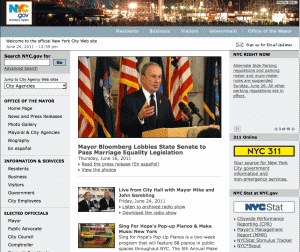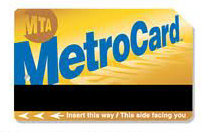New York is an amazing city for news but it can be daunting – even for longtime reporters and residents.
You can save a lot of time if you hit the ground knowing a little about how the city works, its political structure, transportation system – and where to find local news and other key information.
Here are some tips and resources to help you get off to a fast start:
A City of Neighborhoods
As previously mentioned, everybody is going to get a beat within one of the city’s 59 Community Districts. You’ll find an interactive map of the CDs here, along with borough-by-borough, and district-by-district profiles, chock full of demographic and other useful information. You’ll also find the various districts’ budget wish lists – a good place to look for stories.
Those resources are on NYC.gov, the city’s homepage – bookmark this site, you’ll be spending a lot of time there over the next three semesters. The page is the city government’s online presence, where you’ll find such valuable information as listings of police precincts and public schools.

PAGE ONE: NYC.gov, the city's homepage, will become your virtual second home.
You’ll need to know how city government works – this flow chart, while somewhat dense, is a start. The key players – the mayor, comptroller, public advocate, City Council members, borough presidents and others – have pages linking off the NYC.gov homepage. The site also has links to state and federal information pages.
Meanwhile, the recent U.S. Census offers a treasure trove of information about the city – and more granular data is being released by the day. The main U.S. Census site is here, and you can subscribe to news releases here. WNYC produced a handy map showing changes in the city, census tract by census tract. For some examples of how census data can lead to great people-driven stories, check out the NYCity News Service’s recent special report, “Changing New York: Census 2010.”
Mass Media
We’ve stressed the importance of knowing the news. New York, of course, boasts many media outlets of all types and sizes – all potential homes for your work.

GOOD NEWS: New York is brimming with news outlets of all types and sizes. Above is a sampling of outlets that work with the NYCity News Service.
So you’ll need to know what’s going on in the city as you uncover what’s going on in your beat. The media outlets, ranging from TV and radio stations to community and citywide newspapers to hyperlocal websites and blogs, are too numerous list. But here are some sites you might want to visit regularly:
•The New York Times, Daily News and New York Post are online and we have copies in the Newsroom, along with The Wall Street Journal’s Greater New York section (its online presence is called Metropolis). The Daily News publishes neighborhood news sections aimed at Upper Manhattan, the Bronx, Brooklyn and Queens.
•Gotham Gazette, which runs stories about city government issues, has a strong daily news digest (called The Eye Opener) on its homepage, as well as links to many news outlets, government and advocacy sites. The New York Times’ City Room site is a very good source for news, and boasts a comprehensive blogroll. DNA Info offers multimedia coverage of Manhattan neighborhoods. City Limits does a fine job of covering urban issues. The Huffington Post’s New York page offers a helpful aggregation of stories from various outlets, and features feeds of stories from its various “news partners” – including the NYCity News Service.
•All the major TV stations offer newscasts, while local cable news channels NY1 and News12 run around the clock, as do news radio stations WINS, WCBS AM and WNYC. The city also has many magazines well worth reading, including New York magazine and Crain’s New York Business, among others.
There is, obviously, a lot here. It’s a good idea to flip on one of the radio or TV news channels first thing in the morning, and to at least skim the major papers, online or in newsprint. After you’re assigned your neighborhood, identify any relevant local papers and blogs, and add them to your reading list. Do the same for the neighborhood where you live. Consider setting up an RSS feed, Twitter lists and subject-based email alerts to help manage what will be an ever-growing list of news sources.
Getting Around
Pretty much all you need to know about navigating New York comes in an old song with Comden and Green lyrics, bouncing over a Bernstein tune: “The Bronx is up and the Battery’s down. The people ride in a hole in the ground.”
We can add some more modern, less melodic tips to the mix:
•You’ll find subway, bus and railroad maps and information at MTA.info. Be sure to check the site if you’re heading out on weekends or late at night, when routes often are changed because of track work.
Your best bet for getting door-to-door directions is HopStop.com, especially when you are – as you frequently will be as a reporter – on the run.
The last thing you need is another expense. But you might want to consider investing in unlimited MetroCards, as you’ll be bouncing around town quite a bit. The unlimited weekly card costs $29, while the unlimited monthly runs $104.

TICKET TO RIDE: Consider buying a weekly or monthly unlimited MetroCard.
The J-School is not only located at the Crossroads of the World – it is, more importantly, at the Crossroads of New York. You’re within walking or easy transfer distance of just about every subway line.
But it’s not all about mass transportation: One respected colleague likes to say that the best journalism teacher he ever had was Thom McAn (not that our colleague is all that long in the tooth, but for those too young to recall, Thom McAn is a shoe company that’s still kicking but not as popular as it once was). But we take his point: You’re going to be doing a lot of walking on the job. While it’s important that you dress befitting a professional reporter representing our school and our News Service, be sure to don comfortable, hardy footwear.
Bedtime Reading
After all that reading, viewing, talking and walking, you’re going to be pretty tired by the end of the day. So we’ll leave you with a suggestion of a book to keep on your nightstand: “The Power Broker: Robert Moses and the Fall of New York,” by Robert Caro.

POWER SUPPLY: Robert Caro's "The Power Broker" is highly recommended reading.
This 1974 epic biography of the city’s controversial master builder offers a history of modern New York. Just like Rome, New York wasn’t built in a day – and you won’t get through “The Power Broker” all that quickly, either. It’s 1,162 pages (not including footnotes), but well worth reading for background and inspiration as you begin your role in chronicling the ongoing story of New York.




